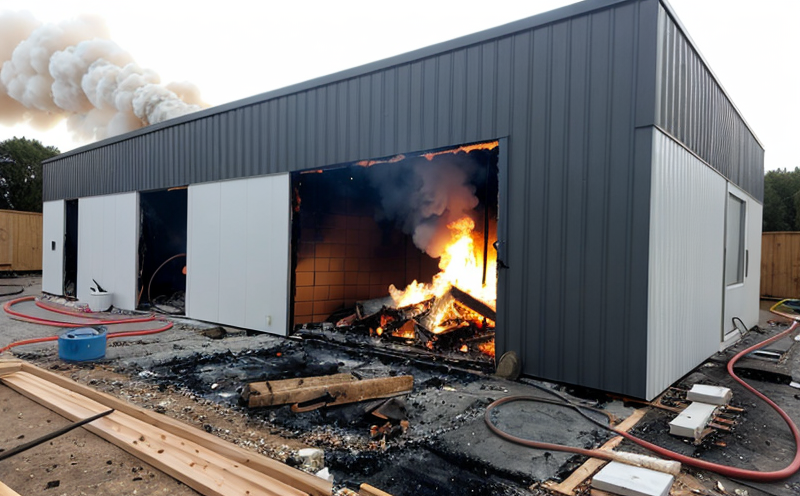Fire Performance Testing of Glass Wool Insulation
The fire performance testing of glass wool insulation is a critical aspect of ensuring building materials meet stringent safety standards. This testing evaluates how effectively the insulation material can resist ignition, flame spread, and heat release under controlled laboratory conditions. The test aims to assess not only the inherent properties of the glass wool but also its behavior in real-world scenarios when exposed to fire.
Testing is performed in accordance with recognized international standards such as ISO 17654-2:2009 and ASTM E84-21. These standards provide detailed protocols for conducting flame spread tests, which are essential for determining the smoke-producing characteristics of materials used in building construction.
During the testing process, specimens of glass wool insulation are subjected to a flame source under specific conditions. Observations include the time it takes for the material to ignite, the rate at which flames spread across its surface, and the amount of heat released during combustion. These parameters are crucial in understanding how the material behaves when exposed to fire.
The testing process is not just about assessing the insulation itself; it also involves evaluating the system as a whole, including the installation method and any other materials used in conjunction with the glass wool. This holistic approach ensures that the final product meets all necessary safety requirements before being deployed in buildings.
For accurate testing results, proper specimen preparation is essential. Specimens must be cut to standard dimensions and shaped according to specified guidelines. The surface of the specimens should be free from any irregularities or defects that could affect test outcomes. Additionally, the specimens need to be conditioned to a specific moisture content to ensure consistent performance.
The instrumentation used in these tests includes specialized equipment designed to simulate fire conditions accurately. This equipment allows for precise control over temperature, humidity, and other environmental factors that can influence the behavior of materials under test. The results are then analyzed using sophisticated software tools that provide detailed insights into the material's performance.
The importance of this testing cannot be overstated, especially given the increasing number of fires in buildings worldwide. By identifying potential weaknesses early on through rigorous testing, architects and engineers can design safer structures that comply with local regulations and international standards. This not only enhances public safety but also contributes to more sustainable building practices.
Real-world applications of this testing are widespread across various sectors, including residential, commercial, and industrial buildings. In the healthcare sector, for instance, fire-resistant materials like glass wool play a vital role in creating safer environments where patients' lives depend on efficient emergency response systems. Similarly, in high-rise office complexes, proper insulation helps maintain optimal internal temperatures while reducing energy costs.
In summary, fire performance testing of glass wool insulation is an indispensable tool for ensuring the safety and reliability of building materials. By adhering to strict international standards and conducting thorough tests under controlled conditions, laboratories can provide valuable data that informs better design decisions and contributes to safer buildings overall.
Applied Standards
- ISO 17654-2:2009: This international standard specifies the procedure for conducting flame spread tests on building materials, including glass wool insulation.
- ASTM E84-21: Developed by the American Society for Testing and Materials (ASTM), this standard provides methods for measuring smoke obscuration in products used in interior finish applications like glass wool.
Customer Impact and Satisfaction
The results of fire performance testing significantly impact customer satisfaction by ensuring that the materials they purchase meet or exceed safety standards. For quality managers, compliance officers, R&D engineers, and procurement teams, these tests offer peace of mind knowing that their products are safe for use in critical environments.
By adhering to strict international standards, customers can be assured that they are investing in materials that have undergone rigorous evaluation processes. This confidence fosters long-term relationships between suppliers and buyers, leading to increased satisfaction levels across the board.
The detailed reports generated from these tests provide valuable information for continuous improvement efforts within organizations. Engineers and designers can use this feedback to refine their products further, addressing any shortcomings identified during testing.
International Acceptance and Recognition
- ISO Standards: Glass wool insulation fire performance tests are widely accepted globally due to the rigorous quality control measures outlined in ISO standards.
- ASTM Standards: Similarly, compliance with ASTM standards ensures broad acceptance within North America and other regions that recognize these guidelines.
- EN Standards: For European markets, adherence to EN (European Norm) specifications is crucial for gaining market access and ensuring product quality.





